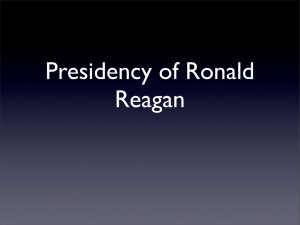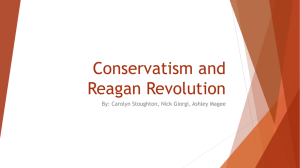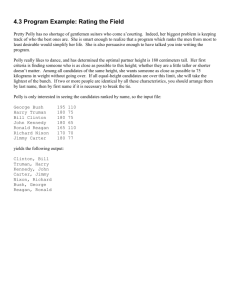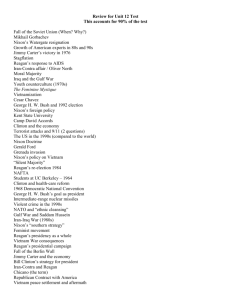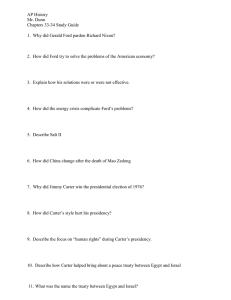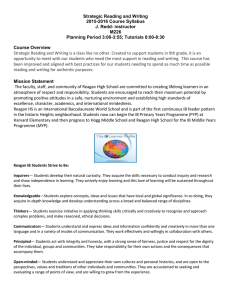Cold War Presidents part 2
advertisement
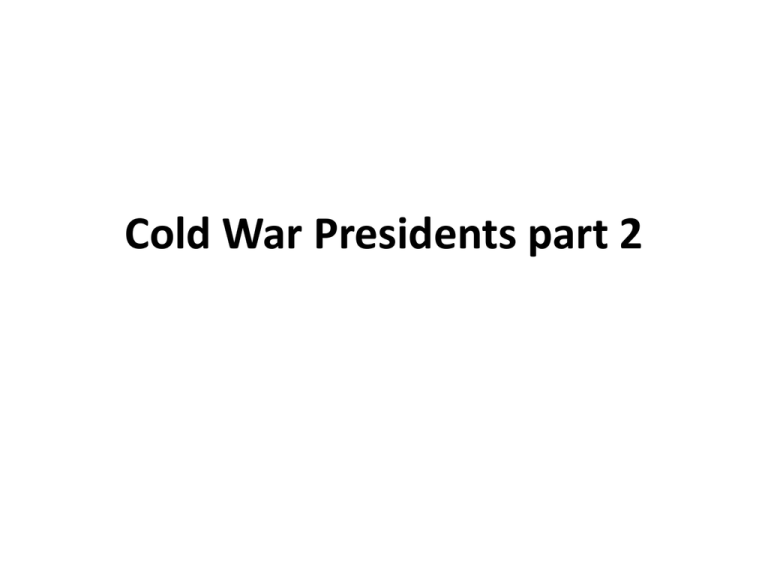
Cold War Presidents part 2 Jimmy Carter • A Washington outsider, Carter had no clue how to play politics • Instead of packing his Cabinet with politically savvy operatives, he chose experts in their respective fields • The economy, having slid into a recession under Ford, tumbles even further after a spike in oil prices Jimmy Carter • Carter’s response was to cut federal spending and ask Americans to conserve energy as a means of improving the economy • Carter’s policies didn’t stimulate the economy • Instead, interest rates soared and price indexes jumped Jimmy Carter • Carter’s push for diplomatic world change is highlighted by the 1978 Camp David Accords • At Camp David, Egyptian President Anwar El Sadat and Israeli Prime Minister Menachem Begin work out a peace agreement • The Camp David Accords formalize relations between the two countries, set the stage for negotiations with the Palestinians, and call for a withdrawal from the West Bank, Gaza and the Sinai Peninsula • Sadat is assassinated by grenades and machine gun fire by fundamentalist Muslims 3 years later The Assassination of Anwar Sadat at a parade, October 6, 1981 Jimmy Carter • Any hope for the U.S. and U.S.S.R. signing the SALT II agreement is dashed when the U.S.S.R. invades Afghanistan • In response to the invasion, the U.S. begins arming the Afghan mullahs (religiously educated Muslim leaders) • These groups are known as mujahideen (Arabic for strugglers; people doing jihad) • CIA and military advisors funnel weapons and training to these Islamic fundamentalists with the mindset of “the enemy of my enemy is my friend” • A portion of these mujahideen eventually form into the Taliban which seize power in Afghanistan after the Soviets leave Osama Bin Laden in a cave while fighting the invading Soviet forces. Jalalabad region, Afghanistan, 1988 Jimmy Carter • During the Soviet/Afghan war, the friendly government in Iran is toppled by hardline Islamic clerics led by Ayatollah Ruhollah Khomeini • The U.S. embassy in Tehran is overrun and 66 Americans are captured and held hostage • After releasing some, 52 hostages were held for 444 days until their release on January 20, 1981 Iranian protesters climb over the gates of the U.S. embassy before storming in to take hostages - Tehran, Nov 4, 1977 Jimmy Carter • The Iran Hostage Crisis killed any chance Carter had against Reagan in the 1980 election • The hostages were released at the completion of Reagan’s inaugural address under the agreement known as the Algiers Accords which stated in part: • The U.S. would unfreeze Iranian assets and settle debts between the two countries • The U.S. would not interfere in Iranian internal affairs either politically or militarily Ronald Reagan • Reagan’s time in office is marked by major political, cultural, military and economic shifts • Politically, the country swung drastically to the right (conservative), so much so that a “liberal” President like Clinton sounded eerily similar to (for his time) a “conservative” Eisenhower • Re-marking the political center of the country allows more religious and neoconservative groups to influence policy decisions from Congress all the way through the court system Ronald Reagan • The result of this access to policy decision making begins a “culture war” wherein conservative ideologues clashed with what they felt to be a society slipping from its previously moral standing • Gay rights, feminism, an increase in evangelical Christianity, “family values” coalitions, and a host of other interest groups fought media and legal battles in hopes of redefining what “America” should be Ronald Reagan • Militarily, Reagan’s term led to increased military spending and re-engagement with the U.S.S.R. following a period of détente started by Nixon’s trip to China and the signing of SALT • Reagan and NATO allies begin installing more missile defenses in countries surrounding the Warsaw Pact states • Leveraging the Soviets’ withdrawal from Afghanistan, Reagan postures the U.S. as ready for a hot war at any minute Ronald Reagan • Reagan refuses to accept the U.S.S.R. as an equal player in the world and terms them an “evil empire” • Instead of directly engaging with the U.S.S.R., Reagan chooses to rely on the ideas of the Truman Doctrine; specifically that the U.S. should stop the spread of communism anywhere and everywhere • He chooses easy targets like Grenada and Nicaragua, both of whom had left leaning governments, to invade (Grenada) and support a rebellion (Nicaragua) Ronald Reagan • Nicaragua turns out to be a nightmare for the CIA and Washington • The Iran-Contra Affair causes an uproar • In a nutshell, in 1985 the CIA sold anti-tank missiles to Iran in exchange for releasing hostages and used the funds to finance the Contras (rebels in Nicaragua) which was banned by Congress • In 1994, the final report on the scandal indicated that both Reagan and George H. W. Bush withheld information and mislead Congress Ronald Reagan • Mikhail Gorbashev, the Secretary of the Communist Party, instituted glasnost (political openness and free discussion) and perestroika (restructuring of the Soviet economy) • This change allowed the U.S. and U.S.S.R. to begin changing how they spent on defense • Gorbashev thought the crushing debt of the arms race was preventing the U.S.S.R. from modernizing like the U.S. Ronald Reagan • Reagan met with Gorbashev in Iceland and agreed to deep cuts in strategic forces • In 1987, Reagan, over the strong objections of many advisors, the CIA and the Defense Department, negotiates the Intermediate Nuclear Force (INF) • The INF calls for the destruction of intermediate range nuclear and conventional missiles • Many of the objections were that the elimination of these weapons will create a strategic vulnerability for the U.S. Ronald Reagan at the Brandenburg Gate delivering his famous 'Tear Down This Wall' speech - June 12, 1987 George H. W. Bush • Initially, Bush was hesitant to engage with Gorbashev, but ultimately agreed to work with him • Several satellite states within the U.S.S.R. embraced the idea of perestroika and eventually agreed to abandon communism in favor of democracy • Effectively, the U.S.S.R. has fallen • On November 9, 1989, the Berlin Wall comes crumbling down A West German man sits atop the Berlin Wall - November 10, 1989 A West Berliner soaked by a water cannon takes a sledgehammer to the wall on November 11, 1989 George H. W. Bush • August, 1991 – An attempted coup against Gorbachev by old-line Communists, is put down • Within the month, the Communist party is banned by the Soviet parliament • By December, 1991, Gorbachev resigned and the remaining 15 component countries of the U.S.S.R. declare their independence George H. W. Bush • Analysts agrees that relentless, open-ended defense and military spending in the arms race helped bankrupt and undermine the U.S.S.R. • Whether or not U.S. spending also weakened the U.S.’s economy and its ability to compete in the world marketplace is a point of debate • Some believe that the demise of the U.S.S.R. is the ultimate justification for 40 years of Cold War spending • Others argue that the collapse showed American politicians greatly exaggerated the threat the Soviets posed • The truth of the matter will probably never been known because Russia will likely never allow their records to be examined by Western analysts
